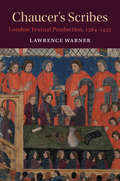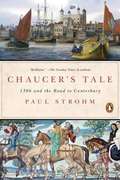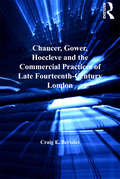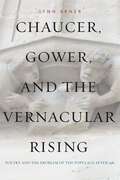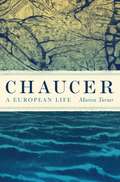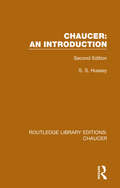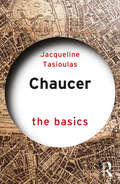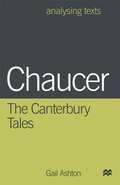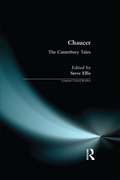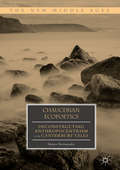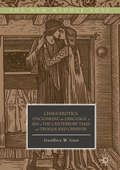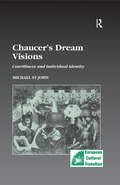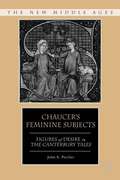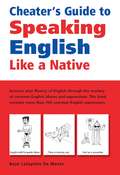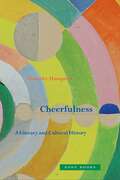- Table View
- List View
Chaucer's Scribes: London Textual Production, 1384–1432 (Cambridge Studies in Medieval Literature)
by Lawrence WarnerThe 2004 announcement that Chaucer's scribe had been discovered resulted in a paradigm shift in medieval studies. Adam Pynkhurst dominated the classroom, became a fictional character, and led to suggestions that this identification should prompt the abandonment of our understanding of the development of London English and acceptance that the clerks of the Guildhall were promoting vernacular literature as part of a concerted political program. In this meticulously researched study, Lawrence Warner challenges the narratives and conclusions of recent scholarship. In place of the accepted story, Warner provides a fresh, more nuanced one in which many more scribes, anonymous ones, worked in conditions we are only beginning to understand. Bringing to light new information, not least, hundreds of documents in the hand of one of the most important fifteenth-century scribes of Chaucer and Langland, this book represents an important intervention in the field of Middle English studies.
Chaucer's Tale
by Paul StrohmA lively microbiography of Chaucer that tells the story of the tumultuous year that led to the creation of The Canterbury Tales In 1386, Geoffrey Chaucer endured his worst year, but began his best poem. The father of English literature did not enjoy in his lifetime the literary celebrity that he has today--far from it. The middle-aged Chaucer was living in London, working as a midlevel bureaucrat and sometime poet, until a personal and professional crisis set him down the road leading to The Canterbury Tales. In the politically and economically fraught London of the late fourteenth century, Chaucer was swept up against his will in a series of disastrous events that would ultimately leave him jobless, homeless, separated from his wife, exiled from his city, and isolated in the countryside of Kent--with no more audience to hear the poetry he labored over. At the loneliest time of his life, Chaucer made the revolutionary decision to keep writing, and to write for a national audience, for posterity, and for fame. Brought expertly to life by Paul Strohm, this is the eye-opening story of the birth one of the most celebrated literary creations of the English language.
Chaucer's Tale
by Paul StrohmA lively microbiography of Chaucer that tells the story of the tumultuous year that led to the creation of The Canterbury TalesIn 1386, Geoffrey Chaucer endured his worst year, but began his best poem. The father of English literature did not enjoy in his lifetime the literary celebrity that hehas today--far from it. The middle-aged Chaucer was living in London, working as a midlevel bureaucrat and sometime poet, until a personal and professionalcrisis set him down the road leading to The Canterbury Tales.In the politically and economically fraught London of the late fourteenth century, Chaucer was swept up against his will in a series of disastrous events that would ultimately leave him jobless, homeless, separated from his wife, exiled from his city, and isolated in the countryside of Kent--with no more audience to hear thepoetry he labored over.At the loneliest time of his life, Chaucer made the revolutionary decision to keep writing, and to write for a national audience, for posterity, and for fame.Brought expertly to life by Paul Strohm, this is the eye-opening story of the birth one of the most celebrated literary creations of the English language.
Chaucer's Troilus and Criseyde (Routledge Library Editions: Chaucer)
by C. David BensonOriginally published in 1990. This study is of one of the world’s great narrative poems and one of the few long poems in English about physical love. Although this work is often overshadowed by the Canterbury Tales, the author argues that it has its own profound multiplicity. Its mixture of genres, styles, characters and other competing elements creates a powerful literary experience for each reader. This book explores the diversity and contradictions produced by the poem without attempting to resolve them. It is accessible to those reading the poem for the first time, but equally stimulating to those who know it well, stressing the importance of the role of individual readers in response to the openness of the poem. Although previous criticism tends to emphasize one or two aspects while ignoring others, Benson argues all critical readings are of interest because they make one aware of the poem’s many contrasting layers and possibilities. Beginning with the principal source, Boccaccio’s Filostrato, the work examines the many different elements added to this source; which contains internal tensions and thus develops Boccaccio’s story in a variety of often contradictory directions. The author considers Chaucer’s treatment of setting, characterization, love, fortune and religion, showing how these affect the character of the poem and make it simultaneously more chivalric and comic, more Christian and more pagan.
Chaucer, Gower, Hoccleve and the Commercial Practices of Late Fourteenth-Century London
by Craig E. BertoletAs residents of fourteenth-century London, Geoffrey Chaucer, John Gower, and Thomas Hoccleve each day encountered aspects of commerce such as buying, selling, and worrying about being cheated. Many of Chaucer’s Canterbury Tales address how pervasive the market had become in personal relationships. Gower's writings include praises of the concept of trade and worries that widespread fraud has harmed it. Hoccleve's poetry examines the difficulty of living in London on a slender salary while at the same time being subject to all the temptations a rich market can provide. Each writer finds that principal tensions in London focused on commerce - how it worked, who controlled it, how it was organized, and who was excluded from it. Reading literary texts through the lens of archival documents and the sociological theories of Pierre Bourdieu, this book demonstrates how the practices of buying and selling in medieval London shaped the writings of Chaucer, Gower, and Hoccleve. Craig Bertolet constructs a framework that reads specific Canterbury tales and pilgrims associated with trade alongside Gower's Mirour de L'Omme and Confessio Amantis, and Hoccleve's Male Regle and Regiment of Princes. Together, these texts demonstrate how the inherent instability commerce produces also produces narratives about that commerce.
Chaucer, Gower, and the Vernacular Rising: Poetry and the Problem of the Populace After 1381
by Lynn ArnerChaucer, Gower, and the Vernacular Rising examines the transmission of Greco-Roman and European literature into English during the late fourteenth and early fifteenth centuries, while literacy was burgeoning among men and women from the nonruling classes. This dissemination offered a radically democratizing potential for accessing, interpreting, and deploying learned texts. Focusing primarily on an overlooked sector of Chaucer’s and Gower’s early readership, namely, the upper strata of nonruling urban classes, Lynn Arner argues that Chaucer’s and Gower’s writings engaged in elaborate processes of constructing cultural expertise. These writings helped define gradations of cultural authority, determining who could contribute to the production of legitimate knowledge and granting certain socioeconomic groups political leverage in the wake of the English Rising of 1381. Chaucer, Gower, and the Vernacular Rising simultaneously examines Chaucer’s and Gower’s negotiations—often articulated at the site of gender—over poetics and over the roles that vernacular poetry should play in the late medieval English social formation. This study investigates how Chaucer’s and Gower’s texts positioned poetry to become a powerful participant in processes of social control.
Chaucer, Gower, and the Vernacular Rising: Poetry and the Problem of the Populace After 1381
by Lynn ArnerChaucer, Gower, and the Vernacular Rising examines the transmission of Greco-Roman and European literature into English during the late fourteenth and early fifteenth centuries, while literacy was burgeoning among men and women from the nonruling classes. This dissemination offered a radically democratizing potential for accessing, interpreting, and deploying learned texts. Focusing primarily on an overlooked sector of Chaucer’s and Gower’s early readership, namely, the upper strata of nonruling urban classes, Lynn Arner argues that Chaucer’s and Gower’s writings engaged in elaborate processes of constructing cultural expertise. These writings helped define gradations of cultural authority, determining who could contribute to the production of legitimate knowledge and granting certain socioeconomic groups political leverage in the wake of the English Rising of 1381. Chaucer, Gower, and the Vernacular Rising simultaneously examines Chaucer’s and Gower’s negotiations—often articulated at the site of gender—over poetics and over the roles that vernacular poetry should play in the late medieval English social formation. This study investigates how Chaucer’s and Gower’s texts positioned poetry to become a powerful participant in processes of social control.
Chaucer, Langland, and Fourteenth-Century Literary History (Variorum Collected Studies #1022)
by Anne Middleton edited by JusticeAnne Middleton's essays have been among the most vigorous, learned, and influential in the field of medieval English literature. Their 'crux-busting' energies have illuminated local obscurities with generous learning lightly wielded. Their historically- and theoretically-informed meditations on the nature of poetic discourse traced how the generation of Chaucer and Langland devised a category of the literary that could embody a ethos of engaged, worldly consensus and make that consensus available to imaginative and rational consideration. And their reflections on the enterprise of literary study found a rational way, free of cant, to understand the work of the literary scholar. This volume reprints eight essays: ’The Idea of Public Poetry in the Reign of Richard II,’ ’Chaucer's 'New Men' and the Good of Literature in the Canterbury Tales,’ ’The Physician's Tale and Love's Martyrs: 'Ensamples Mo than Ten' as a Method in the Canterbury Tales,’ ’The Clerk and His Tale: Some Literary Contexts,’ ’Narration and the Invention of Experience: Episodic Form in Piers Plowman,’ ’Making a Good End: John But as a Reader of Piers Plowman,’ ’William Langland's 'Kynde Name': Authorial Signature and Social Identity in Late Fourteenth-Century England,’ ’Life in the Margins, or, What's an Annotator to Do?’ It includes one essay previously unpublished, ’Playing the Plowman: Legends of Fourteenth-Century Authorship.’
Chaucer: A European Life
by Marion TurnerA groundbreaking biography that recreates the cosmopolitan world in which a wine merchant’s son became one of the most celebrated of all English poets More than any other canonical English writer, Geoffrey Chaucer lived and worked at the centre of political life—yet his poems are anything but conventional. Edgy, complicated, and often dark, they reflect a conflicted world, and their astonishing diversity and innovative language earned Chaucer renown as the father of English literature. Marion Turner, however, reveals him as a great European writer and thinker. To understand his accomplishment, she reconstructs in unprecedented detail the cosmopolitan world of Chaucer’s adventurous life, focusing on the places and spaces that fired his imagination.Uncovering important new information about Chaucer’s travels, private life, and the early circulation of his writings, this innovative biography documents a series of vivid episodes, moving from the commercial wharves of London to the frescoed chapels of Florence and the kingdom of Navarre, where Christians, Muslims, and Jews lived side by side. The narrative recounts Chaucer’s experiences as a prisoner of war in France, as a father visiting his daughter’s nunnery, as a member of a chaotic Parliament, and as a diplomat in Milan, where he encountered the writings of Dante and Boccaccio. At the same time, the book offers a comprehensive exploration of Chaucer’s writings, taking the reader to the Troy of Troilus and Criseyde, the gardens of the dream visions, and the peripheries and thresholds of The Canterbury Tales.By exploring the places Chaucer visited, the buildings he inhabited, the books he read, and the art and objects he saw, this landmark biography tells the extraordinary story of how a wine merchant’s son became the poet of The Canterbury Tales.
Chaucer: Second Edition (Routledge Library Editions: Chaucer)
by S.S. HusseyOriginally published in 1981, this second edition built on the success of the first which had established itself as a standard introduction to the poetry of Geoffrey Chaucer. It shows Chaucer not only in the context of his own age, but, more important, as a writer and a man who is still vivid to us so many years later. As well as examining the early poems, Troilus and Criseyde, and The Canterbury Tales the author gives a thorough account of Chaucer's background. He examines the traditions in which he wrote, his audience, and his position among his contemporaries. The second edition was updated throughout and included a number of revisions and additions, in particular on the second part of the Roman de la Rose and on The Knight's Tale.
Chaucer: The Basics (The Basics)
by Jacqueline TasioulasChaucer: The Basics is an accessible introduction to the works of Geoffrey Chaucer. It provides a clear critical analysis of the texts, while also providing some necessary background to key medieval ideas and the historical period in which he lived. Jacqueline Tasioulas gives a brief account of Chaucer’s life in its historical and cultural context and also introduces the reader to some of the key religious and philosophical ideas of the period. The essentials of the language and pronunciation are introduced through close reading in a section dedicated to demystifying this often alien-seeming aspect of studying Chaucer. Including a whole chapter devoted to poetry the book also discusses key works, such as: The Book of the Duchess The House of Fame The Parliament of Fowls Troilus and Criseyde The Legend of Good Women The Canterbury Tales With glosses and translations of texts, a glossary of key terms and a timeline, this book is essential reading for anyone studying Chaucer and medieval literature.
Chaucer: The Canterbury Tales (Analysing Texts)
by Gail AshtonThis fresh and comprehensive guide to Chaucer's most famous poem The Canterbury Tales introduces readers to Chaucer's life and times and reconsiders both the impact and the context of its inception. It carefully details Chaucer's cultural and literary world, as well as reviewing the publishing history of the Tales and examining some of the issues surrounding the nature of the material production of medieval texts. In addition, it raises matters of 'Englishness' and Chaucer's choice of the vernacular in which to write his works. A highly-readable survey of the critical reception of the Tales, from early responses to recent critical perspectives, works together with a series of exemplary, close readings of key tales and ideas to explore questions such as narrative voice, genre, language and form, gender and authority. This introduction to the text is the ideal companion to study, offering guidance on: Literary and historical context Language, style and form Reading The Canterbury Tales Critical reception and publishing history Adaptation and interpretation Further reading.
Chaucer: The Canterbury Tales (Longman Critical Readers)
by Geoffrey Chaucer Steve EllisThis new addition to the Longman Critical Readers Series provides an overview of the various ways in which modern critical theory has influenced Chaucer Studies over the last fifteen years. There is still a sense in the academic world, and in the wider literary community, that Medieval Studies are generally impervious to many of the questions that modern theory asks, and that it concerns itself only with traditional philological and historical issues. On the contrary, this book shows how Chaucer, specifically the Canterbury Tales, has been radically and excitingly 'opened up' by feminist, Lacanian, Bakhtinian, deconstructive, semiotic and anthropological theories to name but a few. The book provides an introduction to these new developments by anthologising some of the most important work in the field, including excerpts from book-length works, as well as articles from leading and innovative journals. The introduction to the volume examines in some detail the relation between the individual strengths of each of the above approaches and the ways in which a 'postmodernist' Chaucer is seen as reflecting them all.This convenient single volume collection of key critical analyses of Chaucer, which includes work from some journals and studies that are not always easily available, will be indispensable to students of Medieval Studies, Medieval Literature and Chaucer, as well as to general readers who seek to widen their understanding of the forces behind Chaucer's writing.
Chaucerian Ecopoetics: Deconstructing Anthropocentrism in the Canterbury Tales (The New Middle Ages)
by Shawn NormandinChaucerian Ecopoetics performs ecocritical close readings of Geoffrey Chaucer's poetry. Shawn Normandin explains how Chaucer's language demystifies the aesthetic charm of his narratives and calls into question the anthropocentrism they often depict. This text combines ecocriticism with reading techniques associated with deconstruction, to provide innovative interpretations of the General Prologue, the Knight's Tale, the Miller's Tale, the Reeve's Tale, the Franklin's Tale, the Physician's Tale, and the Monk's Tale. In stressing the importance of rhetorical nuance and literary form, Chaucerian Ecopoetics enables readers to better understand the ideological prehistory of today's environmental crisis.
Chaucerian Play: Comedy and Control in the Canterbury Tales
by Laura KendrickThis title is part of UC Press's Voices Revived program, which commemorates University of California Press’s mission to seek out and cultivate the brightest minds and give them voice, reach, and impact. Drawing on a backlist dating to 1893, Voices Revived makes high-quality, peer-reviewed scholarship accessible once again using print-on-demand technology. This title was originally published in 1988.
Chaucerotics: Uncloaking the Language of Sex in The Canterbury Tales and Troilus and Criseyde (The New Middle Ages)
by Geoffrey W. GustChaucerotics examines the erotic language in Chaucerian literature through a unique lens, utilizing the tools of “pornographic literary theory” to open up Chaucer’s ribald poetry to fresh modes of analysis. By introducing and applying the notion of “Chaucerotics,” this study argues for a more historically-nuanced and theoretically-sophisticated understanding of the obscene content in Chaucer’s fabliaux and Troilus and Criseyde. This book demonstrates that the sexually suggestive language of this magisterial Middle English poet could stimulate and titillate various literary audiences in late medieval England, and even goes so far as to suggest that Chaucer might well be understood as the “Father of English pornography” for playing a notable, liminal role in the development of porn as a literary genre. In making this case, Geoffrey W. Gust presents an insightful account of an important intellectual issue and opens up the subject of premodern pornography to consideration in a way that is new and highly provocative.
Chaucer’s Dream Visions: Courtliness and Individual Identity (Studies in European Cultural Transition #7)
by Michael St JohnChaucer used the dream device to engage with the work of French and Italian authors and to explore the philosophical content of their poetry. His four dream visions therefore represent an important conduit through which the influence of European writers was received into English, enabling a profound transition in the way in which the 'self' was conceptualized in medieval courtly literature. Chaucer's Dream Visions is the first book length study to examine the poet's considered use of Aristotelian psychology to describe the mind of the courtly subject in its social context. The study shows that by drawing upon Aristotelian psychology, derived from his reading of Boethius, Dante, and the poets of the French court, Chaucer was able to articulate precisely those aspects of the courtly identity that are determined by language and empirical experience, and those which are transcendent of this determinism. A detailed engagement with the literature, language, and behaviour of the court therefore takes place in the dream visions, which are a genuine exploration of individual subjectivity in its social context. The author of this volume demonstrates that the motivation for this exploration is a product of Chaucer's Christian beliefs and philosophical awareness. Chaucer's Dream Visions thus constitutes a major contribution to the debate concerning distinctions between medieval and early modern culture.
Chaucer’s Feminine Subjects
by John A. PitcherThis study shows how contemporary theory can serve to clarify structures of identity and economies of desire in medieval texts. Bringing the resources of psychoanalytic and poststructuralist theory to bear on Chaucer's tales about women, this book addresses those registers of the Canterbury project that remain major concerns for recent feminist theory: the specificity of feminine desire, the cultural articulation of gender, the logic of sacrifice as a cultural ideal, the structure of misogyny and domestic violence. This book maps out the ways in which Chaucer's rhetoric is not merely an element of style or an instrument of persuasion but the very matrix for the representation of de-centered subjectivity. "
Cheater's Guide to Speaking English Like a Native
by Boye Lafayette De MenteIncrease your fluency of English through the mastery of common English idioms and expressions.All Native English-speakers use a large number of proverbs and colloquial expressions in their daily conversations. These common sayings, which evolved over the centuries, are like "codes" that reveal the cultural values and attitudes of the speakers.To obtain complete fluency in the English language it is necessary to be familiar with these expressions and know how and when to use them.With a user-friendly format, The Cheater's Guide to Speaking English like a Native is a shortcut to achieving that goal.
Check That Fact (Super Quick Skills)
by MorrisKnowing how to check and challenge information is essential for academic study – and our everyday lives. This practical guide shows you how to be savvy about using sources and improve your information literacy. Learn techniques for efficient and effective fact-checking Find out how to evaluate whether a source is credible Identify and challenge misinformation in academia and beyond. Super Quick Skills provide the essential building blocks you need to succeed at university - fast. Packed with practical, positive advice on core academic and life skills, you’ll discover focused tips and strategies to use straight away. Whether it’s writing great essays, understanding referencing or managing your wellbeing, find out how to build good habits and progress your skills throughout your studies. Learn core skills quickly Apply right away and see results Succeed in your studies and life. Super Quick Skills give you the foundations you need to confidently navigate the ups and downs of university life.
Check That Fact (Super Quick Skills)
by MorrisKnowing how to check and challenge information is essential for academic study – and our everyday lives. This practical guide shows you how to be savvy about using sources and improve your information literacy. Learn techniques for efficient and effective fact-checking Find out how to evaluate whether a source is credible Identify and challenge misinformation in academia and beyond. Super Quick Skills provide the essential building blocks you need to succeed at university - fast. Packed with practical, positive advice on core academic and life skills, you’ll discover focused tips and strategies to use straight away. Whether it’s writing great essays, understanding referencing or managing your wellbeing, find out how to build good habits and progress your skills throughout your studies. Learn core skills quickly Apply right away and see results Succeed in your studies and life. Super Quick Skills give you the foundations you need to confidently navigate the ups and downs of university life.
Check These Out: One Librarian's Catalog of the 200 Coolest, Best, and Most Important Books You'll Ever Read
by Gina SheridanDiscover a librarian's secret stash of great reads!We've all been there: in the library, head tilted sideways, doing our best to navigate a blur of spines and titles to find one worth reading. Luckily, the hunt is over. Librarian, author, and book devourer Gina Sheridan has sorted through the stacks to compile a list of read-worthy titles you may have skipped over in your search. Check These Out is her secret stash of books that have captivated her mind and soul throughout the years. Inside, she reveals a wide range of extraordinary yet uncommon stories that will completely change the way you view the world, from Michael Dorris's A Yellow Raft in Blue Water to Herman Melville's The Confidence-Man: His Masquerade. After each suggestion, Sheridan offers a hilariously clever summary as well as surprising details about the book or author.Complete with a checklist to keep track of the titles you've read, Check These Out will help you discover a whole new world of literature you won't believe you missed.
Checking Your Grammar: And Getting It Right
by Marvin Terban Peter SpacekThe best-selling grammar guide gets a fresh, new cover design for Fall 2002. This easy-to-use reference book helps you edit your writing before someone else reads it. Parts of speech * Irregular nouns and verbs The 100 Most Commonly Confused and Misused Words What Makes a Good Sentence Capitalization * Contractions * Compound Words * Idioms Abbreviations * Punctuation * Spelling * Acronyms
Chee-Chalker, The
by L. Ron HubbardDiscover this suspensful tale. FBI agent Bill Norton has been sent to Ketchikan, Alaska to track down his former boss, who's vanished while investigating a heroin smuggling ring. Norton instantly suspects the smugglers are operating from inside the local fishing fleet. But six months and a string of declared "accidental" drownings have failed to turn up any clues.Norton's cold case heats up when the local radio station owner emerges, floating face-down at the docks, and a heart-stopping heiress to the halibut trade makes a maelstrom of trouble. The fact that Norton is well dressed and neatly shaven causes some of the local toughs to mistake the agent for a "chee-chalker"--or newcomer--much to their regret. "Bill Norton, the hero of this adventure, is anything but a tenderfoot. A hero of the classic adventure mold, Norton is tough and rugged, and has a strong sense of honor." --The Strand
Cheerfulness: A Literary and Cultural History
by Timothy HamptonA timely story of a forgotten emotionCheerfulness: A Literary and Cultural History tells a new story about the cultural imagination of the West wherein cheerfulness — a momentary uptick in emotional energy, a temporary lightening of spirit — functions as a crucial theme in literary, philosophical, and artistic creations from early modern to contemporary times. In dazzling interpretations of Shakespeare and Montaigne, Hume, Austen and Emerson, Dickens, Nietzsche, and Louis Armstrong, Hampton explores the philosophical construal of cheerfulness — as a theme in Protestant theology, a focus of medical writing, a topic in Enlightenment psychology, and a category of modern aesthetics. In a conclusion on cheerfulness in pandemic days, Hampton stresses the importance of lightness of mind under the pressure of catastrophe. A history of the emotional life of European and American cultures, a breathtaking exploration of the intersections of culture, literature, and psychology, Cheerfulness challenges the dominant narrative of Western aesthetics as a story of melancholy, mourning, tragedy, and trauma. Hampton captures the many appearances of this fleeting and powerfully transformative emotion whose historical and literary trajectory has never before been systematically traced.
